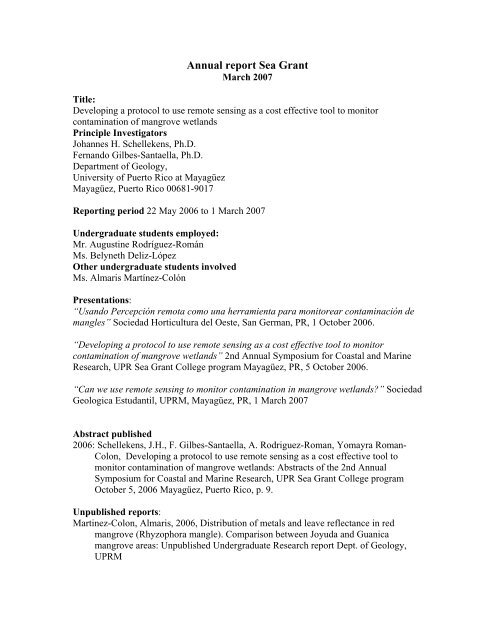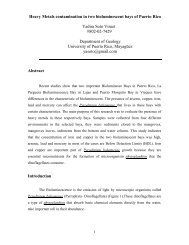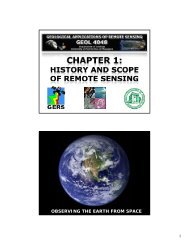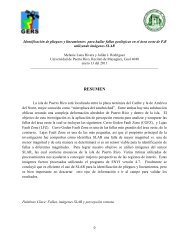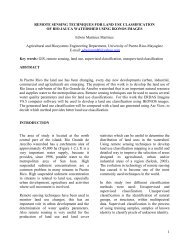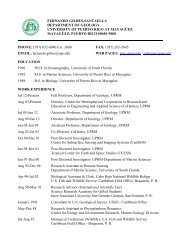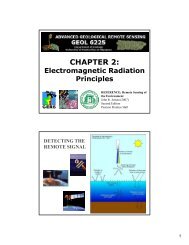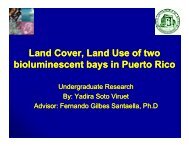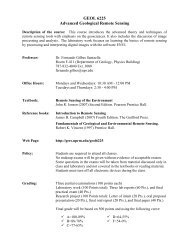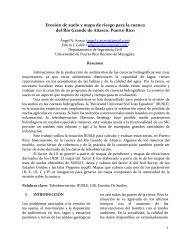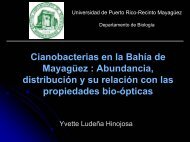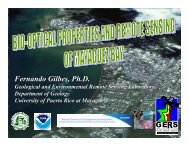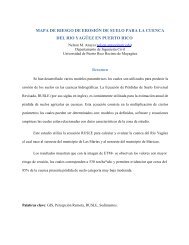See Recent Progress Report - GERS Laboratory at UPRM
See Recent Progress Report - GERS Laboratory at UPRM
See Recent Progress Report - GERS Laboratory at UPRM
Create successful ePaper yourself
Turn your PDF publications into a flip-book with our unique Google optimized e-Paper software.
Annual report Sea Grant<br />
March 2007<br />
Title:<br />
Developing a protocol to use remote sensing as a cost effective tool to monitor<br />
contamin<strong>at</strong>ion of mangrove wetlands<br />
Principle Investig<strong>at</strong>ors<br />
Johannes H. Schellekens, Ph.D.<br />
Fernando Gilbes-Santaella, Ph.D.<br />
Department of Geology,<br />
University of Puerto Rico <strong>at</strong> Mayagüez<br />
Mayagüez, Puerto Rico 00681-9017<br />
<strong>Report</strong>ing period 22 May 2006 to 1 March 2007<br />
Undergradu<strong>at</strong>e students employed:<br />
Mr. Augustine Rodríguez-Román<br />
Ms. Belyneth Deliz-López<br />
Other undergradu<strong>at</strong>e students involved<br />
Ms. Almaris Martínez-Colón<br />
Present<strong>at</strong>ions:<br />
“Usando Percepción remota como una herramienta para monitorear contaminación de<br />
mangles” Sociedad Horticultura del Oeste, San German, PR, 1 October 2006.<br />
“Developing a protocol to use remote sensing as a cost effective tool to monitor<br />
contamin<strong>at</strong>ion of mangrove wetlands” 2nd Annual Symposium for Coastal and Marine<br />
Research, UPR Sea Grant College program Mayagüez, PR, 5 October 2006.<br />
“Can we use remote sensing to monitor contamin<strong>at</strong>ion in mangrove wetlands?” Sociedad<br />
Geologica Estudantil, <strong>UPRM</strong>, Mayagüez, PR, 1 March 2007<br />
Abstract published<br />
2006: Schellekens, J.H., F. Gilbes-Santaella, A. Rodriguez-Roman, Yomayra Roman-<br />
Colon, Developing a protocol to use remote sensing as a cost effective tool to<br />
monitor contamin<strong>at</strong>ion of mangrove wetlands: Abstracts of the 2nd Annual<br />
Symposium for Coastal and Marine Research, UPR Sea Grant College program<br />
October 5, 2006 Mayagüez, Puerto Rico, p. 9.<br />
Unpublished reports:<br />
Martinez-Colon, Almaris, 2006, Distribution of metals and leave reflectance in red<br />
mangrove (Rhyzophora mangle). Comparison between Joyuda and Guanica<br />
mangrove areas: Unpublished Undergradu<strong>at</strong>e Research report Dept. of Geology,<br />
<strong>UPRM</strong>
Deliz-López, Belyneth and Rodríguez -Román, Augustine, 2006, Monitoring metal<br />
contamin<strong>at</strong>ion of mangroves using remote sensing techniques: Guayanilla: Internal<br />
Research report Dept. of Geology, <strong>UPRM</strong><br />
Narr<strong>at</strong>ive:<br />
In August 2006 we advertised two positions of undergradu<strong>at</strong>e research assistants<br />
in the project. Four undergradu<strong>at</strong>e students responded: 2 females and 2 males. We hired<br />
Ms. Belyneth Deliz and Mr. Augustine Roman. Both undergradu<strong>at</strong>e students carried out<br />
leave reflectance measurements in the field and collected leave and sediment samples for<br />
chemical analysis. A third undergradu<strong>at</strong>e student particip<strong>at</strong>ed as part of her course GEOL<br />
4055 Undergradu<strong>at</strong>e Research II. The three students carried out chemical analyses in the<br />
Atomic Absorption Spectrometer (AAS) labor<strong>at</strong>ory of Dr. Arturo Massol under the<br />
supervision of Ms. Elba Diaz.<br />
In order to learn more about the movement of metals in the mangroves and the<br />
effect of these metals on the leave reflectance, a test was designed where the composition<br />
of the soils was compared to the composition and reflectance of leaves <strong>at</strong> three levels<br />
within the tree (lowest, middle and top level). In order to avoid difference due to<br />
mangrove species, only leaves of the red mangrove (rhyzophora mangle) were used for<br />
this test. This semester the leaves were analyzed for Cu, Co, Cd, Ni, and Pb. The AAS<br />
labor<strong>at</strong>ory was equipped to do these analyses. The toxic metal As and Hg are planned for<br />
next semester after the special chemicals ordered have arrived.<br />
Reflectance measurements were taken by cutting 5 leaves <strong>at</strong> each level (lowest,<br />
middle, and top) (figure 1). From each leave 10 reflectance measurements were taken<br />
(figure 2). Giving 5 x 10 x 3= 150 measurements per tree, in each area 3 trees were<br />
sampled, giving a total of 450 reflectance measurements per sample area. The leaves of<br />
the three levels were collected for chemical analysis. The sample areas selected for these<br />
tests were: Joyuda Lagoon (with n<strong>at</strong>ural Ni, Co contamin<strong>at</strong>ion, and reported As contents),<br />
Guayanilla (possible industrial contamin<strong>at</strong>ion, reported Hg), Guanica (probable pristine<br />
environment next to Tropical Dry forest reserve, with carbon<strong>at</strong>e rocks and no substantial<br />
run-off).
Figure 1. Sampling of mangrove leaves<br />
using a pole-pruner<br />
Figure 2. Measuring the reflectance of the<br />
leaves using the GER 1500 spectroradiometer.<br />
Initial results<br />
A number of analyses were carried out in the labor<strong>at</strong>ory of Dr. Massol in the department<br />
of Geology with the help of Ms. Elba Diaz. Chemical results are listed in the tables 1 to<br />
3.
Table 1. Summary chemical analyses substr<strong>at</strong>es (Rodriguez, 2006) (all points are the<br />
average of four samples)<br />
Ni ppm Cu ppm Co ppm Pb ppm Cd ppm<br />
Guayanilla 30 128 14 5 0<br />
Guanica 4 70 1 11 0<br />
Arecibo 15 72 5 15 0<br />
Joyuda 141 63 11 5 0<br />
Table 2. Chemical composition leaves of Rhyzophora mangle in the Guayanilla area<br />
(Rodriguez and Deliz, 2006)<br />
Cd ppm Pb ppm Cr ppm Cu ppm Ni ppm<br />
GL1B 0 7 0 31 2<br />
M 0 10 0 24 1<br />
T 0 10 1 24 1<br />
GL2B 0 14 8 29 1<br />
M 0 12 2 25 1<br />
T 0 7 2 27 0<br />
GL3B 0 8 5 34 1<br />
M 0 8 3 52 0<br />
T 0 10 13 69 0<br />
All analyses are the average of two analyses. B, M, and T refers to the level of the leaves<br />
in the tree: Bottom, Middle, and Top<br />
Table 3. Chemical composition leaves of Rhyzophora mangle in the Joyuda area<br />
(Martinez, 2006)<br />
Cd ppm Cu ppm Ni ppm<br />
JO1B 0 53 4<br />
M 0 79 22<br />
T 0 60 4<br />
JO2B 0 65 12<br />
M 0 19 6<br />
T 0 100 4<br />
JO3B 0 10 4<br />
M 0 19 6<br />
T 0 18 1
Red Mangrove Guayanilla loc 1<br />
Ni<br />
Cu<br />
Cr<br />
Top<br />
Middle<br />
GL1Bottom<br />
Pb<br />
Cd<br />
0 5 10 15 20 25 30 35<br />
metal in ppm<br />
Red Mangrove Guayanilla loc 2<br />
Ni<br />
Cu<br />
Cr<br />
Pb<br />
Top<br />
Middle<br />
GL2Bottom<br />
Cd<br />
0 5 10 15 20 25 30 35<br />
metal in ppm<br />
Red mnagrove Guayanilla loc 3<br />
Ni<br />
Cu<br />
Cr<br />
Pb<br />
Top<br />
Middle<br />
GL3Bottom<br />
Cd<br />
0 10 20 30 40 50 60 70 80<br />
metals in ppm<br />
Figure 3. Chemical vari<strong>at</strong>ion diagrams. Comparison of red mangroves (Rhyzophora<br />
mangle) of Guayanilla form three loc<strong>at</strong>ions, separ<strong>at</strong>ed in top, middle or lower leaves of<br />
the canopy.<br />
Discussion of the chemical d<strong>at</strong>a<br />
Table 1 shows the chemical analyses available for the substr<strong>at</strong>e from previous<br />
undergradu<strong>at</strong>e research projects. The sites were selected for their possible contamin<strong>at</strong>ion:<br />
Joyuda (Acevedo et al, 2000), Guayanilla (Lopez and Teas, 1978), Arecibo or for their<br />
pristine n<strong>at</strong>ure, Guanica. If the Guanica area is indeed the non-contamin<strong>at</strong>ed site as was<br />
expected, the metal values may be base-line values for Puerto Rico. The Ni and Co are<br />
low as was expected, but the values for Cu (70 ppm) and Pb (11 ppm) are higher than<br />
expected. Cu may be always present in this amount, but the Pb is higher than in<br />
Guayanilla and Joyuda and may be a result of local pH conditions or contamin<strong>at</strong>ion.<br />
The high content of Ni and Co in the Joyuda Lagoon was expected next to the Guanajibo<br />
Ni-Co l<strong>at</strong>erite deposit (Cram, 1972). The Arecibo area was selected because it formed<br />
part of the drainage basin of the porphyry copper deposits (Plaza-Toledo, 2005).<br />
Surprisingly the values for both Pb and Cu are comparable to the supposedly pristine<br />
Guanica area. Guayanilla, for which Hg contamin<strong>at</strong>ion was reported (Lopez and Teas,<br />
1978) shows a fairly high content in Ni and Co, also the Cu is twice as high as the other<br />
analyzed areas.<br />
Leave analyses were carried out in order to determine the movement of metal in the trees.<br />
Did the metal move from the substr<strong>at</strong>e into the plant and did the metal move to the top of
the canopy, where it s<strong>at</strong>ellite based detectors would be able to see influence of the metal<br />
on the chlorophyll production and hence on the reflectance p<strong>at</strong>tern.<br />
The most complete set of d<strong>at</strong>a <strong>at</strong> this moment are the chemical analyses of a red<br />
mangrove (rhyzophora mangle) in the Guayanilla Mangrove area. Cd and Ni are low and<br />
Cu and Pb show a considerable content. It is not clear yet how significant the difference<br />
between the lower, middle and top leaves is. St<strong>at</strong>istical analyses are planned to<br />
investig<strong>at</strong>e this. The presence of Cu and Pb in the leaves probably reflects the presence of<br />
these metals in the substr<strong>at</strong>e. Analyses for Hg and As will be carried out this semester.<br />
Chemical have been purchased to be able to do these analyses.<br />
The d<strong>at</strong>a presented for Joyuda look suspect. The substr<strong>at</strong>e contains considerable amounts<br />
of Ni and Co (Table 1). The Cu in the leaves may be a reflection of the Cu in the<br />
substr<strong>at</strong>e, but previous analyses showed a high content of Ni, so there is a possibility of<br />
mix up of the analytical d<strong>at</strong>a. This possibility will be further investig<strong>at</strong>ed.<br />
Reflectance measurements<br />
The reflectance of the red mangrove leaves was measured using the GER 1500<br />
radiospectrometer.<br />
Reflectance of Red Mangrove Guayanilla Loc. 2 Bottom Level<br />
0.8<br />
0.7<br />
0.8<br />
Reflectance of Red Mangrove Loc. 2 Middle Level<br />
0.6<br />
0.7<br />
0.5<br />
Loc. 2 Leaf 1 Bottom<br />
0.6<br />
Reflectance<br />
0.4<br />
0.3<br />
Loc. 2 Leaf 2 Bottom<br />
Loc. 2 Leaf 3 Bottom<br />
Loc. 2 Leaf 4 Bottom<br />
Loc. 2 Leaf 5 Bottom<br />
Reflectance<br />
0.5<br />
0.4<br />
0.3<br />
Loc. 2 Leaf 1 Middle<br />
Loc. 2 Leaf 2 Middle<br />
Loc. 2 Leaf 3 Middle<br />
Loc. 2 Leaf 4 Middle<br />
Loc. 2 Leaf 5 Middle<br />
0.2<br />
0.2<br />
0.1<br />
0.1<br />
0<br />
400 500 600 700 800 900<br />
Wavelength<br />
0<br />
400 500 600 700 800 900<br />
Wavelenght<br />
Reflectance of Red Mangrove Guayanilla Loc. 2 Top Level<br />
0.8<br />
0.7<br />
0.6<br />
Reflectance<br />
0.5<br />
0.4<br />
0.3<br />
Loc. 2 Leaf 1 Top<br />
Loc. 2 Leaf 2 Top<br />
Loc. 2 Leaf 3 Top<br />
Loc. 2 Leaf 4 Top<br />
Loc. 2 Leaf 5 Top<br />
0.2<br />
0.1<br />
0<br />
400 500 600 700 800 900<br />
Wavelength<br />
Figure 4 Reflectance p<strong>at</strong>terns of Red mangrove (Rhyzophora mangle) of Guayanilla<br />
loc<strong>at</strong>ion 2. The three subfigures are the reflectance p<strong>at</strong>terns of the lower, middle and top<br />
leaves of the tree.
Discussion of the reflectance p<strong>at</strong>terns<br />
An example of the reflectance p<strong>at</strong>terns is given in figure 4. As is clear the vari<strong>at</strong>ion<br />
between the reflectance p<strong>at</strong>terns within one level of the tree is just as large as the<br />
vari<strong>at</strong>ion between the different levels. Not all reflectance p<strong>at</strong>terns collected have been<br />
corrected. In addition to a close look <strong>at</strong> the p<strong>at</strong>terns to elimin<strong>at</strong>e incorrect results, staitical<br />
analyses of the vari<strong>at</strong>ion in p<strong>at</strong>terns should be made. Metal content tends to affect<br />
chlorophyll production and as a result the loc<strong>at</strong>ion of the IR shoulder. This will be<br />
analyzed using the deriv<strong>at</strong>ive of the curves<br />
Future plans:<br />
• A large amount of d<strong>at</strong>a is now available and the next step is to carry out quality<br />
control on the reflectance d<strong>at</strong>a. Many reflectance curves show anomalous values<br />
th<strong>at</strong> will have to be checked and possibly elimin<strong>at</strong>ed.<br />
• St<strong>at</strong>istical analysis of the reflectance p<strong>at</strong>terns and the chemical d<strong>at</strong>a will be carried<br />
out in order to study the significance of the vari<strong>at</strong>ion. The first deriv<strong>at</strong>ive of the<br />
p<strong>at</strong>tersn will be compared to the chemical composition in order to detect any<br />
correl<strong>at</strong>ion.<br />
• Several areas will added to the study: Arecibo with possible Cu and Pb<br />
contamin<strong>at</strong>ion, Ponce where DNRA reports contamin<strong>at</strong>ion, Punta Verraco, where<br />
neighbors claim chemical test where carried out.<br />
• S<strong>at</strong>ellite images will be selected and purchased.<br />
• Presently the project only employs undergradu<strong>at</strong>e students. Gradu<strong>at</strong>e student will<br />
be recruited to continue and expand the research to fulfill the plans of the<br />
proposal.<br />
References<br />
.<br />
Acevedo, D., Rodriguez-Sierra, C.J., Reyes, D.R., and Jimenez, B.D., 2000, Heavy<br />
metals in sediments and w<strong>at</strong>er from San José and Joyuda Lagoons in Puerto Rico,<br />
in: J.A. Centeno et al. Editors, Metal Ions in Biology and Medicine, volume 6, p.<br />
169-172.<br />
Cram, C.M., 1972, Estudio preliminar de geología económica del yacimiento niquelífero<br />
Barrio Guanajibo: Comisión de Minería, Depto. De Recursos N<strong>at</strong>urales de Puerto<br />
Rico.<br />
Lopez, J.M. and Teas, H.J., 1978, Trace element cycling in magroves: Symposium on<br />
Physiology of Plants in Coastal Ecosystems with emphasis on trace metal<br />
cycling, Blacksburg VA.<br />
Stary, S.J. and Lopez, J.M., 1979. A study of the mercury concentr<strong>at</strong>ions of the red<br />
mangroves of the south and west coasts of Puerto Rico: Center for Energy and<br />
Environmental Research M-43.


